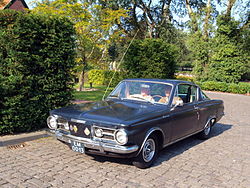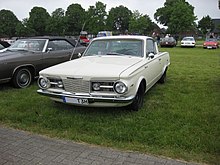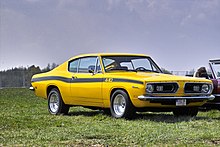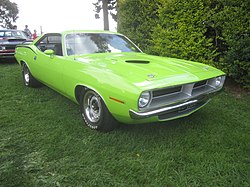Plymouth Barracuda
| Plymouth Barracuda | |
|---|---|
| Production period: | 1964-1974 |
| Class : | Middle class |
| Body versions : | Coupé , convertible |
The Plymouth Barracuda was a passenger car that Chrysler manufactured under the Plymouth brand in the 1964-1974 model years.
Model history
Barracuda (1964-1966)
| 1st generation | |
|---|---|
|
Plymouth Barracuda (1965) |
|
| Production period: | 1964-1966 |
| Body versions : | Coupé , convertible |
| Engines: |
Gasoline engines : 2.8-4.5 liters (approx. 75-170 kW) |
| Length: | 4780 mm |
| Width: | |
| Height: | 1359-1367 mm |
| Wheelbase : | 2692 mm |
| Empty weight : | |
All automobile manufacturers in the USA brought sporty compact cars onto the market in the early to mid- 1960s . Chrysler chose the Plymouth Valiant as the basis for this . The Ford Mustang , which ultimately sold significantly better than the Barracuda, provided this class of vehicle with the name " Pony Car ", but the Plymouth Barracuda Fastback appeared two weeks earlier, on April 1, 1964. The Plymouth management actually wanted the car Call it "Panda", which the designer didn't like. Finally, John Samsen prevailed with his proposal "Barracuda". It is named after the fish of the same name .
The Barracuda had a wheelbase of 2,692 mm from the Valiant , the bonnet , the surrounds for the headlights, the windshield , the front triangular windows, the fenders and the bumpers; all other sheet metal parts and windows were new. It was a typical hardtop coupe that lacks the B-pillar . Using the existing platform reduced the cost of development, tooling, and development time for the new model. The hatchback shape was designed with a 1.3 m² panoramic rear window that was pulled around to the C-pillar, which was set far forward. This largest window ever used in mass production of passenger cars was made by Pittsburgh Plate Glass (PPG).
The mechanics corresponded to that of the Valiant, including two versions of the Chrysler Slant-6 engine , a 2.8-liter engine with 75 kW in the basic equipment and an optionally available 3.7-liter with 108 kW. A brand new 4.5 liter Chrysler LA V8 with 134 kW and a twin carburetor was the largest machine for 1964; the performance was initially quite low. The base price for the Barracuda was US $ 2,512. 1964 was not only the first year for the Barracuda, but also the last year that the TorqueFlite automatic push-button system was offered; thus the 1964 Barracuda was the only one with this equipment.
In the 1965 model year, the 3.7-liter engine became the base engine for the USA; in Canada this remained the 2.8 liter. As the competition in the “pony car” segment intensified, there were new special equipment: A Commando version of the 4.5-liter engine with four-fold carburetor, a compression ratio of 10.5: 1, a sharper camshaft and other improvements introduced, which delivered 175 kW. There was also the Formula S package, which, in addition to the Commando V8, included reinforced wheel suspension, larger wheels and tires, special emblems and a tachometer. Factory- fitted disc brakes and air conditioning were introduced after the start of the model year. In addition, in the 1965 model year, the fenders and taillights of the 1964 Barracuda were adopted for the Valiant (except for the station wagon, which got its own taillights).
In 1966 the Barracuda got new taillights, a new front and a new dashboard. The latter offered space for an oil pressure gauge and a rev counter. With the exception of the radiator grille, the front of the vehicle was shared by the 1966 Barracuda with the Valiant of the same year, which gave the front fenders a more angular shape. The deluxe models also had flippers mounted on the fenders. The bumpers were bigger and the grille had a solid grille. For the first time there was a center console on request.
Although the first barracudas looked very similar to the contemporary Valiant, they wanted Plymouth to be understood as a separate model range. So in 1965 the “Valiant” lettering that still appeared on the trunk lid of the 1964 models was abandoned. In 1966 the cars were equipped with a Barracuda-specific, stylized fish logo, only in export markets such as Canada and South Africa , where Valiant was marketed as a separate car brand, the name Valiant Barracuda remained until the 1st generation Barracuda was discontinued in 1969.
The Barracuda also influenced the design of other Chrysler vehicles. On the other side of the Atlantic , the Chrysler Company in Great Britain , the former Rootes Group , developed the Hillman Hunter- based Sunbeam Rapier hatchback coupe in 1967 , which showed striking parallels to the Barracuda of the 1964–1966 model years, although the design responsible for the styling Director of Rootes, Roy Ax, denied any direct connection.
Barracuda (1967-1969)
| 2nd generation | |
|---|---|
|
Plymouth Barracuda Convertible (1967) |
|
| Production period: | 1967-1969 |
| Body versions : | Coupé , convertible |
| Engines: |
Otto engines : 3.7–7.2 liters (approx. 105–285 kW) |
| Length: | 4897 mm |
| Width: | |
| Height: | 1336 mm |
| Wheelbase : | 2692 mm |
| Empty weight : | |
The second generation of the Barracuda still had the A-chassis with a 2,692 mm wheelbase and many components of the Valiant, but had been completely redesigned and given Barracuda-typical styling. It also offered its own range of models, including convertibles and hardtop models with hatchbacks and notchbacks. The gradually increased US safety standards for cars during this period made it possible to differentiate between the individual model years of the second Barracuda generation: The 1967 models did not yet have side lights or reflectors on the fenders, the 1968 models without round side lights Reflectors and the 1969 models rectangular side reflectors without lights.
As the "pony car" class had established itself and the competition increased, Plymouth revised the engine range. The "225-slant-6" engine (3.7 liters) was still the basic engine, the possibilities of the V8 in 1967 ranged from 4.5 liters with double or quadruple carburettors to the rarely ordered 6.3 liter Chrysler B- Big block.
In 1968 the 4.5 liter was replaced as the smallest V8 by a 5.2 liter LA engine and the new four-carburettor LA engine with 5.6 liters was introduced. In 1969, Chrysler's largest V8, the 7.2 liter RB engine, was also available. There were even 50 super-stick barracudas without street legal approval with the Chrysler Hemi engine, which were built for drag races along with 50 Dodge Darts with the same equipment in 1968. For South Africa, a high-performance version with 140 kW of the 3.7-liter "slant 6" engine - called "Charger Power" - was offered, with a compression ratio of 9.3: 1, a double carburetor, a sharper camshaft and a Had exhaust system with less drag. A handful of Savage GT vehicles were also built.
In 1969, Plymouth put more emphasis on availability and marketing. The 6.3 liter engine now delivered 243 kW and a new equipment package called Cuda was introduced. The Cuda was based on the Formula S package and was available with a displacement of 5.6 or 6.3 liters.
Barracuda (1970–1974)
| 3rd generation | |
|---|---|
|
Plymouth Barracuda (1970) |
|
| Production period: | 1970-1974 |
| Body versions : | Coupé , convertible |
| Engines: |
Gasoline engines : 3.2–7.2 liters (approx. 105–285 kW) |
| Length: | 4740 mm |
| Width: | about 1900 mm |
| Height: | 1293 mm |
| Wheelbase : | 2743 mm |
| Empty weight : | 5.2 V8: 1435 kg |
In 1970 the Barracuda lost all commonality with the Valiant. The all-new 1970s model was based on a shorter and wider version of the Chrysler B-chassis, which was called the E-chassis. The hatchback model disappeared from the model range, which now only consisted of notchback and cabriolet models. There was also a sister model to Dodge that was named Challenger ; However, the two vehicles had no sheet metal parts in common and the Challenger had a 5 cm longer wheelbase. Both vehicles looked very aggressive and the high performance models were sold again as Cuda . The engine compartment of the E-chassis was larger than that of the earlier A-chassis, so that the 7.0-liter Chrysler Hemi engine could now be offered on a regular basis.
There were two six-cylinder engines - a new 3.2 liter of the "slant-6" and the 225 (3.7 liter) - as well as six different V8 engines: with 5.2 liters, 5.6 liters, 6.3 liters , 7.2 liters (with four-way carburetor), 7.2 liters (with three double carburettors "Six Pack") and with a displacement of 7.0 liters (the latter was the Chrysler Hemi engine). The vehicles with 7.0 and 7.2 liter engines had better wheel suspensions and reinforced chassis to bring the engine power to the road. The barracudas were available with labeling sets, modified bonnets and some unusual "high-impact" colors such as vitamin C , in- violet and Moulin Rouge .
The racing drivers Swede Savage and Dan Gurney drove identical factory Cudas ( All American Racers ) in the 1970s Trans-Am series with the best prospects (3 pole positions) and little success (no first place). The AAR-Cudas were equipped with 5.6-liter eight-cylinder engines with three double carburetors.
With the 440-6 (7.2 liter displacement, six-fold carburetor) and the 426 Hemi (7.0 liter displacement), the performance of the factory-made Barracuda models became legendary. The quarter mile times were 13.7 seconds and 103 mph (165 km / h) and 13.4 seconds and 108 mph (173 km / h), respectively. But this performance also had its price: The test reports from this time criticized the narrow, uncomfortable interior of the vehicles and their extremely small trunk. They were also accused of poor handling and poor braking, especially if they were equipped with the larger, heavier engines.
In 1971 the Barracuda was slightly redesigned and received a new grille and different taillights. 1971 was the only model year in which it was equipped with four main headlights, and also the only year with fender "gills". The engine equipment remained the same as in the previous year, only the 7.2 liter engine with four-way carburetor was no longer available. The model with the 426 Hemi engine (7.0 liters) also remained, and the corresponding convertible from 1971 is now considered the rarest and most sought-after Barracuda. Only 12 pieces were made, seven of which remained in the United States. The six surviving to date were sold for US $ 2,000,000 each.
In the model years 1970 and 1971 there were two remarkable options: the Shaker Hood (an air scoop that is directly connected to the engine and protrudes through the hood and "shakes" with the engine) and the Dana-60 rear axle from Spicer. The Shaker Hood was available for the engines with 5.6 liters, 6.3 liters, 7.2 liters (four-way carburetor) and 7.2 liters (six-way carburetor), as well as for the 7.0-liter Hemi engine. The massive (and heavy) Dana 60 with 9 ″ differential was available as standard equipment together with the manual gearbox and the 7.2 liter engine with six-fold carburetor or the Hemi engine. It was available as an option for vehicles with automatic transmissions. The compression of all engines was slightly lowered in order to accommodate the new petrol with less lead added.
After another revision of the grille and taillights in 1972, the Barracuda remained unchanged until the end of production in 1974 with only two main headlights and four taillights. But - as with all other vehicles of the time - the performance of the barracudas decreased rapidly in these years to meet the new safety and emissions regulations. The compression of the engines was reduced year after year, which also reduced their power output. At the same time, the bumpers grew in size and weight, and in 1973 heavy side impact protection struts had to be installed in the doors.
In 1974 there were only engines with 5.2 liters and 5.9 liters displacement. Higher gasoline prices and surcharges on insurance premiums for high-performance vehicles made many buyers lose interest in these cars; after 1970 sales fell rapidly and on April 1, 1974, exactly 10 years after production of the Barracuda began, the model was discontinued.
Technical specifications
| model | 5.2 |
|---|---|
| Number of cylinders | V8 |
| Displacement (cm³) | 5211 |
| Max. Power (kW / PS) | 110/150 at 4400 min -1 |
| Max. Torque (Nm) | 352 at 2000 min -1 |
| Top speed (km / h) | 179 |
| Transmission (standard) | 3-speed automatic |
| Acceleration (0-100 km / h) | 13.4 s |
| Combined consumption (l / 100 km) | 14.0 p |
| Tank capacity | - l |
| Price (1974) | $ 3,252 |
Current status
The Barracuda is one of the most sought-after pony and muscle cars today, and they achieve a correspondingly high price. The rarity of certain models and equipment combinations is mainly due to the lack of interest from buyers at the time.
In 2007, Motor Trend magazine spread a rumor that Chrysler wanted to reissue the Barracuda in 2009 along with the re-acquired Dodge Challenger to compete against the Ford Mustang and Chevrolet Camaro . But since the Plymouth brand was discontinued in 2001, the new Barracuda should appear as Chrysler. A member of the Chrysler management described this as unlikely, which he was right.
Web links
- Allpar.com Plymouth Barracuda Page (English)
swell
- Young, Tony: “Mighty Mopars 1960-1974”, Motorbooks International (1984), p. 25, ISBN 978-0879381240
- The history of John Samsens Plymouth Barracuda (English)
- The Barracuda production figures in 1970 by Power Team (English)
- Return of the 'Cuda of Motor Trend (English)
- Car and Driver: Spied: 2008 Dodge Challenger - Car News (English)
Individual evidence
- ↑ Article at www.mopar.ch ( page no longer available , search in web archives ) Info: The link was automatically marked as defective. Please check the link according to the instructions and then remove this notice.











